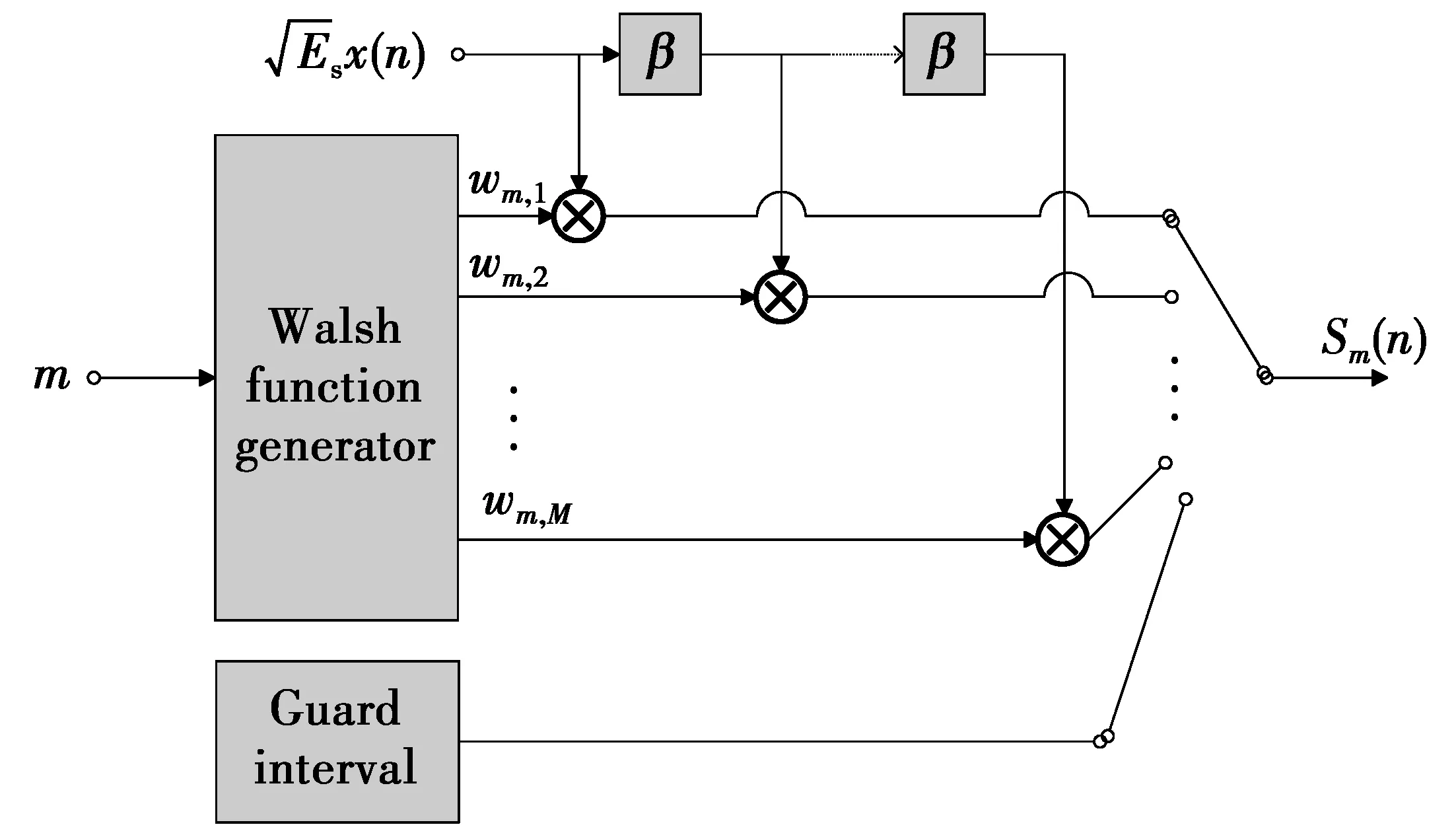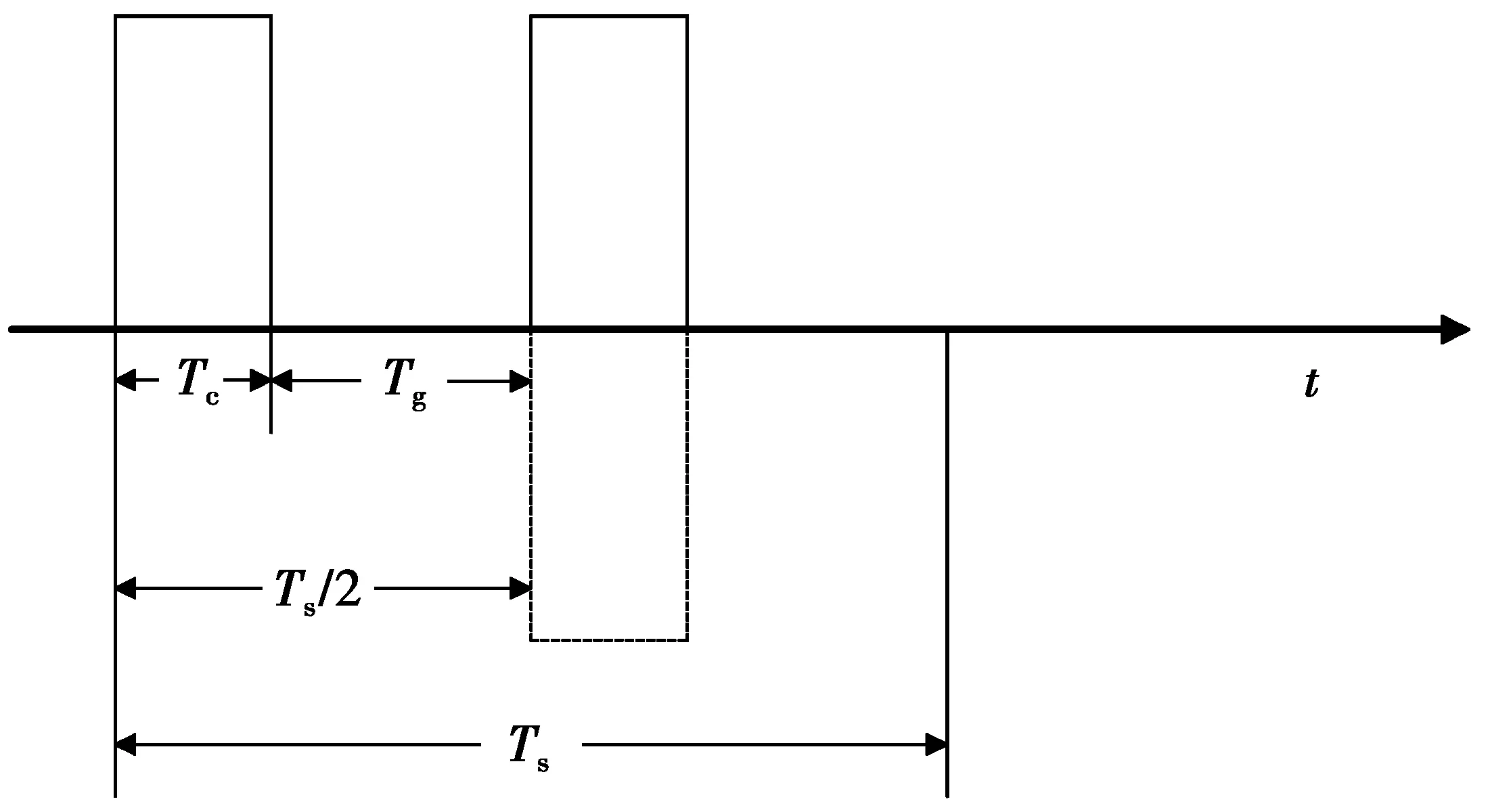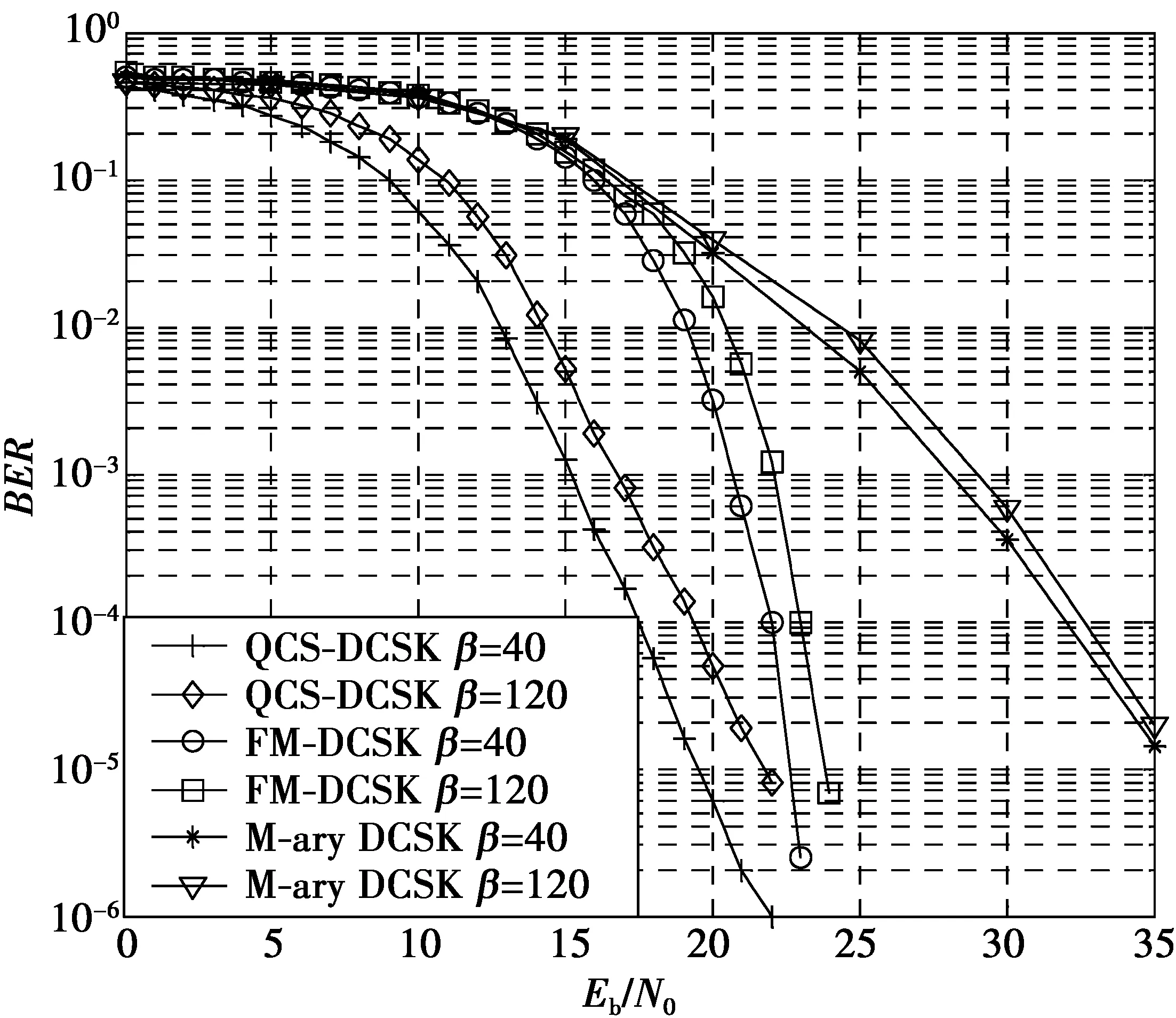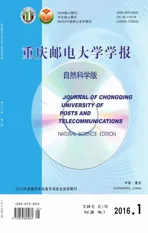不同混沌调制方式在基于超宽带系统的体内信道下的性能表现
2016-06-29曹学鹏吕毅博黄婷婷
曹学鹏,吕毅博,黄婷婷,王 琳
(1.重庆邮电大学 通信与信息工程学院, 重庆 400065;2.厦门大学 信息科学与技术学院, 福建 厦门361005)
不同混沌调制方式在基于超宽带系统的体内信道下的性能表现
曹学鹏1,吕毅博2,黄婷婷2,王琳2
(1.重庆邮电大学 通信与信息工程学院, 重庆 400065;2.厦门大学 信息科学与技术学院, 福建 厦门361005)
摘要:混沌调制(differential chaos shift keying, DCSK)技术应用于超宽带(ultra wideband, UWB)短距离传输系统具有潜在的优势。提出了分别基于多元DCSK(M-ary DCSK, M-DCSK)、调频DCSK(frequency modulation-DCSK, FM-DCSK)和QCS-DCSK(quadrature code shifted-DCSK)的超宽带无线体内传输系统,分析了提出的基于最新几种混沌调制的超宽带体内传输系统的BER(bit error ratio)性能,对影响基于混沌调制的超宽带体内传输系统性能的参数积分时间和保护间隔做了理论研究和仿真分析。通过设置不同的扩频因子,在体内信道下QCS-DCSK相比M-DCSK及FM-DCSK能够确保更好的传输质量,且功率损耗更低。在给定扩频因子β和信号持续时间Tc时,存在能使QCS-DCSK系统性能达到最优的保护间隔。在设定扩频因子β、信号持续时间Tc和保护间隔Tg时,存在能够使FM-DCSK系统性能达到最优的积分间隔。
关键词:混沌调制;超宽带;体内信道;保护间隔;积分间隔
1Introduction
By using a chaotic carrier [1-2] to spread a digital signal over a wide bandwidth spectrum, the resulting system inherits the benefits of spreading-spectrum communications such as mitigation of multipath fading. Based on this observation, a number of chaos-based communication schemes have been proposed and analyzed in recent years. Among all the digital communication schemes proposed so far, differential chaos shift keying(DCSK) shows superior capability in terms of anti-interference over multipath fading channels. Therefore, the DCSK system is well suited for the short-range wireless communications based on the chaotic-UWB(ultra wideband) technique, and it is a promising candidate for use in wireless personal area network(WPAN) system[3-4].
UWB technology can greatly improve the communication quality between medical implants and external units because of its efficiency with respect to multi-path fading, high transmission speed, and simple structure [5]. However, accurate characterization of the propagation channel is extremely important to the efficient design of UWB implant wireless communication system. The IEEE 802.15.6 standardization group has issued several models for medical and nonmedical devices [6], both in-body and on-body, for wireless body area networks (WBANs).
Meanwhile, the UWB channel model for implant sensor communication also has been discussed in [7-9]. However, the performance of several DCSK modulation schemes over the UWB in-body channel has not been investigated.
This paper aims at comparing performances of different DCSK modulation schemes, i.e.M-ary DCSK [2], frequency-modulated DCSK (FM-DCSK) [3] and quadrature code-shifted DCSK (QCS-DCSK)*submitted to IEEE Transactions on Circuits and System, over the UWB in-body channel and confirming an optimal DCSK modulation scheme for the UWB in-body channel. When compared with the representative residential channel, it can be found that the performance of FM-DCSK on the UWB in-body channel is better than the one over former channel. Simultaneously, the BER performances of these three modulation schemes over the UWB in-body channel model are also presented. These simulation results suggest that QCS-DCSK outperform other two DCSK modulation schemes when BER bigger than 10-7.
2Signals design and system model
Due to their inherent common characters,M-ary DCSK, FM-DCSK and QCS-DCSK are all suited for multipath fading channel. To eliminate the inter symbol interference (ISI), guard intervalTgis introduced to all three DCSK schemes. Apparently, there are different aspects existed between these three schemes.M-ary DCSK modulation was introduced and investigated as a multilevel version of DCSK system in [10] and [11]. The receiver in this system adopts noncoherent demodulator. The transport mechanism among multi-parameter of FM-DCSK system under realistic multipath channel model is studied in [3]. Different from other two schemes, the integral time in FM-DCSK is half of the symbol period. The QCS-DCSK system*is able to form four-level information constellation without additional equipment where a modulated symbol is consisted with two bits of data. A novel receiver is applied in this system, which is immune to RF delay line by means of the properties of Walsh function.
2.1M-ary DCSK system
Fig.1 presents the structure of theM-ary DCSK modulator. ForM-ary DCSK modulation scheme, the bits-to-symbols mapping can be expressed as:
(1)
Here, mdenotesm-thsymbol.AsdepictedinFig.1,Walshfunctionisintroducedtoorthogonalizechaoticsignalsinthemodulator.ItcanbeeasilyverifiedthattwoarbitraryWalshfunctionvectors,vectorwm=[wm,0,wm,1,…,wm,M]andvectorwj=[wj,0,wj,1,…wj,M]satisfy
(2)

Fig.1 StructureofM-aryDCSKmodulator.
Consideringthefactthatachaoticsignalhasaspreadingfactorβ,itcanbeexpressedasβdiscretepoints,namely, x=(x1,x2,…,xβ), satisfying
(3)
Then the m-thmodulatedM-arysymbolisexpressedas
(4)

Clearly, a received signal, which is transmitted through the UWB in-body channel can be decomposed as y(j)=Sm(j)+n(j), where n(j) denotes thej-th sampled Gaussian noise with zero means and varianceσ2.
The structure of demodulator is depicted in Fig.2.

Fig.2 Structure of M-ary DCSK noncoherent demodulator
2.2FM-DCSK UWB system
In FM-DCSK UWB system, each information symbol is divided into two parts, the reference chaotic signal and the information-bearing signal. If bit “0” to be transmitted, the information signal is the inverted version of the reference signal, while, if bit”1” to be transmitted, the information signal is identical to the reference signal. The block diagram of FM-DCSK UWB transmitter and receiver are showed in Fig.3, and the transmitted signal structure is showed in Fig.4.
In the system, the chaotic reference signalg(t) is given by
(5)
wherec(.) is chaotic signal,Tcis chaotic carrier duration,Tsis symbol length, andTgis guard interval. The transmitted signals(t) corresponding to one information symbolIis as follow,
(6)
The received signalγ(t)=s(t)⊗h(t)+n(t), whereh(t) is channel impulse response, ⊗is the convolution product. We define the signal before decisiony(t),
(7)
LetTibe the integral time, wheny(t)≥0,the out of decision will be bit“1”,whiley(t)<0,it will be bit“0”.

Fig.3 Block diagram of FM-DCSK UWB transmitterand receiver

Fig.4 Chaotic UWB signal structure
2.3QCS-DCSK UWB system
Quadrature code-shifted differential chaos shift keying (QCS-DCSK) system utilizes the transmitter of Code-shifted differential shifted keying (CS-DCSK) system, and applies a novel receiver which is immune to RF delay line.

Rel=[cxl+Tgcxl+Tgcxl+Tgcxl+Tg]
(8)In1=[cxl+Tg-cxl+Tgcxl+Tg-cxl+Tg]
(9)
In2=[cxl+Tgcxl+Tg-cxl+Tg-cxl+Tg]
(10)

Fig.5 Transceiver of QCS-DCSK scheme with code order N=4
where cxl=[cxl1,…,cxlk] is vector of chaotic wavelet consisting ofKsamples with durationTcduringl-th symbol. The length ofTgisnK. According to mapping process of Tab.1, the information signal ofl-th symbol can be generated as
Ml=aIn1l+bIn2l
(11)
(12)

(14)

Tab.1 Chaotic mapping process
3UWB in-body channel
3.1Channel impulse response
IntheUWB,pathlossandpowerdelayprofile(PDP)aremostimportantparametersofreflectingcharacterizationofthepropagationchannel.Inthispaper,wemainlydiscussthepowerdelayprofile.SupposingthatthegainofPDPisasinglemodel,thechannelimpulseresponse(CIR)canbepresentedas
(19)
whereαkandτkarethegainanddelayofthek-thmultipathcomponent(MPC),andNisthetotalnumberofMPCs.
3.2Distribution of MPCs amplitude
Thepowervariationsofthek-thMPCpeakoftheCIRatdepthdfollowaGaussiandistribution(inlinearscale)withμk(d), σk(d). μk(d)canbewrittenas
(20)
whereΩ0(d)istheaveragepowerofthefirstMPCpeakandλ(d)isthedecayexponentofthepeaks,foragivendepthd.Andσk(d)isaconstant,whendisagivenvalue.
3.3Distribution of MPCs time delay

(21)
whereΘ0(d)andΛ(d)areconstantsforagivendepth.
4Simulation results and discussion
Basedontheequationsmentionedabove,theUWBin-bodychannelmodelisbuiltonmatlabandCC++platform.TodemonstratethecharacterizationoftheUWBin-bodychannel,comparisonsofBERperformancesofFM-DCSKmodulationschemewithspreadingfactorβ=40overtheUWBin-bodychannelandtheresidentialchannel,whichisthemodified802.15.3achannelmodel,aredisplayedinFig.6.ThissimulationresultssuggestthattheenvironmentoftheUWBin-bodychannelisbetterthanthatoftheresidentialchannel.

Fig.6 BER performances of FM-DCSK over In-bodychannel and Residential channel, β=40
Then,theperformancesofM-aryDCSK(M=4)andFM-DCSKschemesovertheUWBIn-bodychannelareselectedtocomparewiththatofQCS-DCSKwithdifferentspreadingfactorsβ=40, 120inFig.7.ItshowsthatQCS-DCSKexhibitsthebestBERperformanceamongallthecomparedschemesforallpresentedβofthewholeEb/N0valueswhenBERbiggerthan10-7.Therefore,QCS-DCSKfulfillstherequirementoflowpowerconsumptioninmedicalUWBsystem.

Fig.7 BER performance of QCS-DCSK, FM-DCSKand M-ary DCSK (M=4) over In-body channel

Fig.8 BER performance of QCS-DCSK over in-bodychannel with different guard interval Tg, β=80
Inthispaper,theeffectsofguardintervalandintergratationintervalarediscussedrespectively.InFig.8,withgivenspreadingfactorβ=80anddurationTc=4ns,theBERperformancesofQCS-DCSKoverIn-bodychannelwithdifferentguardintervallengthTg=4ns,8ns,16ns,20nsarepresented.Basedontheseresults,itcanbefoundthatanoptimalguardintervallengthisexited.Thatisbecausewhenincreasingthelengthofguardinterval,ontheonehand,theISIiseliminated,ontheotherhand,morenoiseisintroducedtoreceiver.InFig.9 ,withgivenspreadingfactorβ=20,durationTc=2nsandTg=198ns,theBERperformancesofFM-DCSKoverIn-bodychannelwithdifferentSNREb/N0=12dB, 14dB, 16dB, 18dBarepresented.Basedontheseresults,anoptimalintegratationintervallengthisfound.WhileinM-aryDCSKandQCS-DCSKmodulationscheme,Theoptimalintegratationisnotfound.

Fig.9 BER performance of FM-DCSK over in-body channelwith different SNR Eb/N0, β=20
5Conclusions
Inthispaper,theUWBin-bodychannelismodeled,whichisessentialfortheUWBmedicalcommunicationsystemdesign.TheperformanceofFM-DCSKoverin-bodychannelandtheoneoverresidentialchannelarecompared.TheresultsuggeststhattheenvironmentoftheUWBin-bodychannelisbetterthanthatoftheresidentialchannel.Simultaneously,theBERperformancesofM-aryDCSK,FM-DCSK,andQCS-DCSKoverin-bodychannelwithdifferentspreadingfactorsverifythatQCS-DCSKisagoodcandidatemodulationschemefortheUWBin-bodychannel,whichrequireslowertransmittingpowerwhenBERat10-6.ForgivenspreadingfactorβanddurationtimeTc,thesimulationresultsofQCS-DCSKoverin-bodychannelwithdifferentguardintervalsshowthattheoptimalguardintervalcanensurethebestperformanceofQCS-DCSKovertheUWBin-bodychannel.Withgivenspreadingfactorβ,durationtimeTcandguardintervalTg,theoptimalintegratationintervalcanimprovetheperformanceofFM-DCSKovertheUWBin-bodychannel.
References
[1]LAUFCM,TSECK.Chaos-BasedDigitalCommunicationSystems:Operatingprinciples,AnalysisMethods,PerformanceEvaluation[M].Berlin:Springer-Verlag,2003.
[2]KISG.Performanceanalysisofchaoticcommunicationsystems[D].Budapest,Hungary:BudapestUniversityofTechnologyandEconomics, 2005.
[3]KOLUMBNG.UWBtechnology:chaoticcommunicationversusnoncoherentimpulseradio[C]∥EuropeanConferenceonCircuittheoryandDesign.Cork,Ireland:CircuitTheoryandDesign, 2005: 79-82.
[4]CHENZX,XUWK,HUANGJ,etal.PerformancesofCS-DCSKUWBCommunicationSysteminthePresenceofNarrowBandInterferers[C] ∥The12th IEEE IUCC.Liverpool,UK:IEEEPress, 2012: 1475-1480.
[5]ALLENB,BROWNT,SCHWIEGERK,etal.Ultrawideband:Applications,technologyandfutureperspectives[C]∥InternationalWorkshoponConvergentTechnologies.Oulu,Finland:InternationalWorkshoponConvergentTechnologies(IWCT), 2005.
[6]YAZDANDOOST,SAYRAFIAN.ChannelModelforBodyAreaNetwork(BAN):IEEEP802. 15-08-0780-12-0006[S/OL]. (2010-11-10) (2012-07-27).https:∥mentor.ieee.org/802.15/documents?n=4 &is_group=0006.
[7]WANGQ,MASAMIK,WANGJ.ChannelmodelingandBERper-formanceforwearableandimplantUWBbodyarealinksonchest[C] ∥IEEEInternationalConferenceonUltra-Wideband.Vancouver,Canada:IEEEPress, 2009: 316-320.
[8]WANGJ,WANGQ.ChannelmodelingandBERperformanceofanimplantUWBbodyarealink[C]∥IEEE. 2009 2ndInternationalSymposiumonAppliedSciencesinBiomedicalandCommunicationTechnology.Bratislava:[s.n.], 2009, 24-27.
[9]KHALEGHIA,CHAVEZSantiagoR,LIANGX,etal.Onultrawidebandchannelmodelingforin-bodycommunications[C] ∥IEEEInternationalSymposiumOnWirelessPervasiveComputing.Modena,Italy:IEEEPress, 2010: 140-145.
[10]WANGL,MINX,CHENGR.PerformanceofSIMOFM-DCSKUWBsystemBasedonChaoticPulseClusterSignals[J].IEEET-ransactionsonCircuitsandSystem, 2011, 58(9): 2259-2268.
[11]FANGY,CHENPP,WANGL.PerformanceanalysisandoptimizationofacooperativeFM-DCSKUWBsystemunderindoorenvironments[J].IETCommunications, 2012, 1(2): 58-65.
Biography:

CAOXuepeng(1988-),Male,Shanxi,master,Theresearcharea:Communicationsystemofwirelessbodyareanetwork(WBAN)E-mail:cxp8601066@163.com.
(编辑:魏琴芳)
收稿日期:2014-11-14
修订日期:2014-12-30通讯作者:曹学鹏cxp8601066@163.com
基金项目:国家自然科学基金(61271241,61001073)
Foundation Items:The National Natural Science Foundation of China(61271241,61001073)
